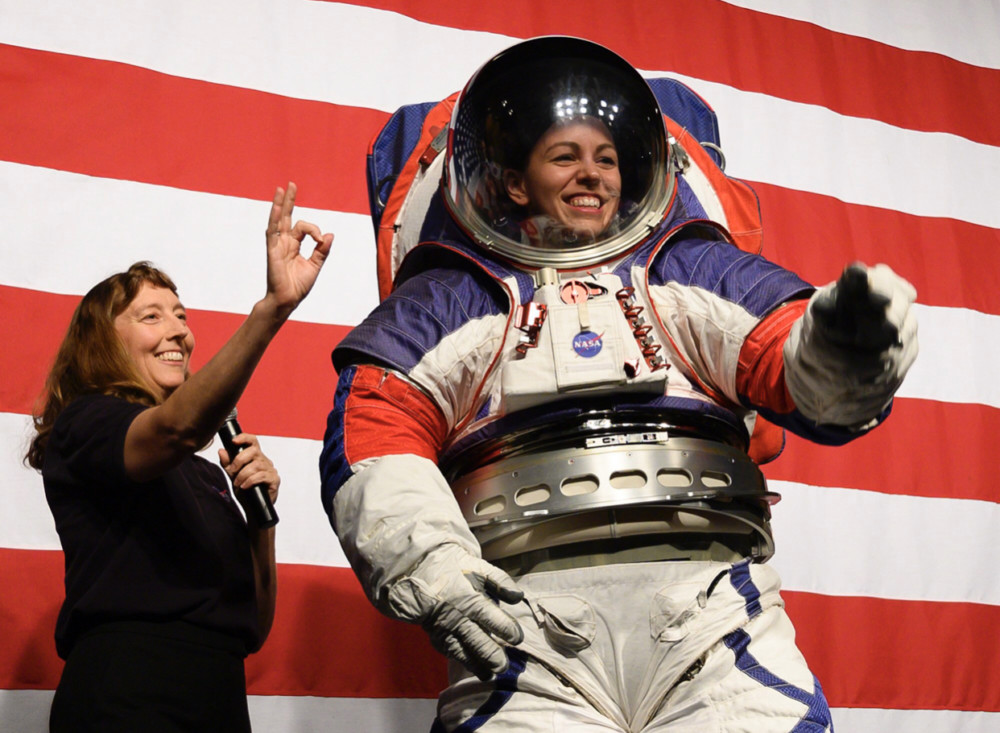By Richard Tribou
Orlando Sentinel
WWR Article Summary (tl;dr) As Richard Tribou reports, “NASA is set to have two female astronauts go on a spacewalk for the first time ever this week on board the International Space Station, a feat that took longer than originally planned because there were not enough EVA suits to fit two women at the same time.”
Orlando Sentinel
When NASA sends astronauts back to the moon, they will be wearing a new generation of spacesuit.
NASA Administrator Jim Bridenstine hosted and event in Washington on Tuesday showing off the two outfits it plans to use for the Artemis missions that plan to return humans to the surface of the moon.
“Ultimately the goal is this: We’re going to Mars and in order to go Mars we have to use the moon as a proving ground,” Bridenstine said. “We need to learn how to live and work on the surface of another world for long periods of time and in order do that friends we need spacesuits.”
He then introduced two new spacesuits. One was the pressurized suit for extravehicular activity such as walking on the moon worn by NASA engineer Kristine Davis, and the other for use in the Orion capsule to and from the moon worn by Orion crew survival project manager Dustin Gohmert.
Bridenstine reiterated NASA’s schedule to return to the surface of the moon by 2024, including having the first woman walk on the lunar surface.
“To be clear, Kristine is wearing a spacesuit that will fit all of our astronauts when we go to the moon,” Bridenstine said.
NASA is set to have two female astronauts go on a spacewalk for the first time ever this week on board the International Space Station, a feat that took longer than originally planned because there were not enough EVA suits to fit two women at the same time.
NASA spacesuit engineer Amy Ross explained how Davis’ suit, called the Exploration Extravehicular Mobility Unit, differs from those used in the Apollo program including its greater mobility.
“We’ve been working for a long time to build spacesuits that will do the job on the moon and going on to Mars,” Ross said.
buy premarin online www.mobleymd.com/wp-content/languages/new/premarin.html no prescription
“So basically my job is take a basketball, shape it like a human, keep them alive in a harsh environment and give them the mobility to do their job.”
Now astronauts will be able to reach across their body and even raise their hands above their head. The lower torso of the suit will also be designed to allow for much better movement.
“If you remember the Apollo generation, your remember Neil Armstrong and Buzz Aldrin they bunny hopped on the surface of the moon,” Bridenstine said. “Well now we’re actually going to be able to walk on the surface of the moon which is very different that our suits of the past.”
Ross also explained the suits lunar design will allow for its use across a 500-degree temperature range, from 250 degrees Fahrenheit to -250 degrees, and that Apollo-era suit features such as zippers are long gone to combat the harsh moon dust that can be a scourge to lunar spacesuits. The pressurizes suit uses 100 percent oxygen to allow for immediate extravehicular activity that won’t force astronauts to combat pressure sickness.
For Mars, which has an atmosphere, the design will need to adjust to allow for similar temperature, pressure and environmental needs.
For the Orion suit, used in the pressurized crew capsule that will head to the moon atop the Space Launch System, the outfit is designed to give astronauts maximum use of space.
“This is the suit that gets us there and gets us home safely,” Gohmert said. “So this suit is fully integrated with the vehicle from the ground up so when it’s tailored to the human body, it’s also tailored to the seat so we have 100 percent fit in the vehicle and 100 percent integration with the Orion ECLS (Environment Contral and Life Support) system.”
Bridenstine’s drive for the Artemis program looks to populate a gateway space station by 2028.
“We want it to be sustainable,” he said. “We’re going to be able to stay at the moon for long periods of time … a permanent and reusable command module around the moon for 15 years.”
___
Distributed by Tribune Content Agency, LLC.














































































































































































































































































































































































